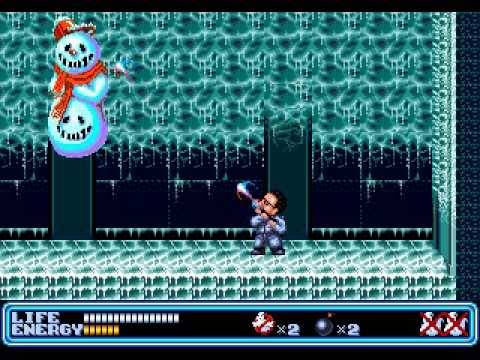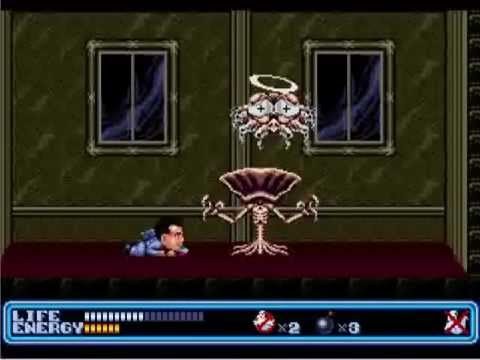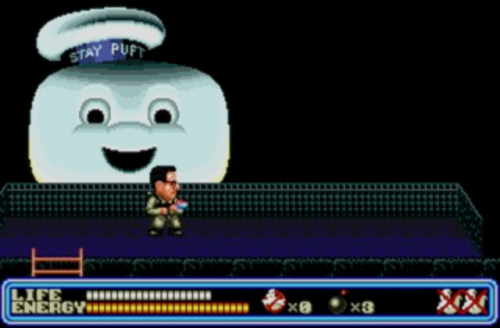



http://darth-azrael.tumblr.com/post/165978968437/creaturesofnight-who-you-gonna-call




http://darth-azrael.tumblr.com/post/165978968437/creaturesofnight-who-you-gonna-call
Source: Next Generation – Issue Number 9 – September 1995
Star Trek: Deep Space Nine – Crossroads of Time was an action adventure game for the Super Nintendo and Sega Genesis based on the Star Trek: DS9 TV series. It was released in 1995 which would have been around the third season of the show and still pretty early in the series.
At the time the game was released, it received pretty mixed reviews. The graphics, sound and general atmosphere were praised for being very good and true to the show. The gameplay on the other hand left a little more to be desired. Action scenes were mostly simplistic, repetitive and the controls somewhat awkward. The rest of the game played more like a puzzle game. Fans of the show will probably get some enjoyment out of it but otherwise it wouldn’t hurt to skip this one.
If you do seek this game out, the only way you can get it is for the Genesis and Super Nintendo. It hasn’t had any newer releases that I am aware of. Of the two, the Super Nintendo has somewhat better graphics but both are pretty good in this department and the gameplay is more or less the same. I’ve always been a little surprised that there weren’t more console Star Trek games in the age of Next Generation and DS9 but this is one of only a few choices available at the time and none of the others was based on DS9.
It was Sega’s attempt at trying to allow Genesis Owners a cheaper means of having 32x gaming capabilities and to bide their time until the Saturn would be released. It had originally been intended to be a separate console of it’s own called the Sega Neptune which would be a combined Sega 32x and Sega Genesis.

Sega Prototypes were built, only one however (as shown in the image above) has ever been found and it resides today at the US Video Game Museum in Dallas, Texas.

While reception of the 32X was originally positive was a failure commercially. Due to being released 6 months before the Saturn, and the rather small Game library (45 games) It never reached the potential it could have.


Retrospectively the biggest problems with the 32x is that it is a hilariously bad design overall. Looking like a tumor coming out of a Genesis 1, and a Mushroom cloud coming out of a Genesis 2.
Like with the Sega CD, The 32x originally came with extra pieces. an RF shield that would permanently open up the Sega Genesis Cartridge slot so the 32x could stay in permanently. and an extra black piece of plastic that would make it sit better on a Genesis Model 2.
Both pieces like the expansion covers for the Genesis usually go missing. The RF shield is something that can be left off but the plastic piece to make it sit better on the Genesis Model 2 is required if you do have a Genesis Model 2. Otherwise you need to remove the 32x to put cartridges into it then put the 32x back into the genesis.
The 32X, like the Genesis and the Sega CD, Required it’s OWN power source. As the Angry Videogame Nerd best put it, “It looks like the Genesis is on life support.”
http://darth-azrael.tumblr.com/post/164442856421/kitsuneofinari-the-sega-32x-was-released-on-the
The Sega 32X is an interesting piece of gaming hardware. It was designed as an add-on for the Sega Genesis mostly to compete with the Atari Jaguar but also because of fears that the Saturn’s release would be delayed. The 32X was really a piece of video game hardware that was in a very awkward price/performance category and awkwardly timed as well. It wasn’t as powerful as the upcoming Saturn and though it also wasn’t nearly as expensive, it required a Genesis and still had a hefty enough $160 price tag on its own. The awkward timing of its release (just before the Saturn) ensured that it would be a commercial failure.
While the 32X was not as powerful as the Saturn, it did share the same dual SH-2 architecture. This gave Sega and third party developers a chance to practice for the Saturn so to speak by programming for this dual CPU architecture. I’m not sure how effective that was given that there were relatively few games and few third party developers for the 32X. Upon the Saturn’s introduction, it was notoriously hard to develop for and developer tools were not as mature as they could have been.
The 32X plugged into the cartridge port of the Genesis and could accept 32X games or act as a pass-through for regular Genesis games so you didn’t have to remove the 32X. It could also work in conjunction with the Sega CD for 32X enhanced Sega CD games though there were only ~6 such titles. The 32X unit required its own power supply and an additional umbilical to the Genesis so it definitely made for a clunky looking system, particularly if you also had the Sega CD. An all-in-one Genesis/32X was planned called the Neptune but it was never released because Sega realized it would be competition for the Saturn.
The Sega 32X hardware consisted of the following:
All of this was in addition to being able to use Genesis and Sega CD resources.
As far as games were concerned, there weren’t very many. There were a total of 40-45 32X games, many were slightly enhanced Genesis games or otherwise weren’t very good because development was rushed to beat the Saturn. However, there are a few good ones to watch out for. Star Wars Arcade, Virtua Fighter and Shadow Squadron are all decent games that take reasonable advantage of the 32X hardware. For an example of a game that was obviously rushed, check out Doom. It is missing levels, has choppy game play and poor sound. While it was better than 16-bit versions of the game, the 32X hardware should have been capable of delivering a much better version (The Jaguar version was far superior). Unfortunately, we never really got to see what the 32X was capable of. It did not have a long enough life span for developers to really learn how to make the most of the system. Based on the specs, it should have been capable of games much closer to Saturn quality than Genesis quality but this was not the reality in most cases.